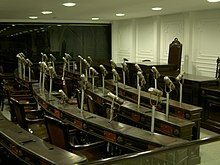브라질의 초인플레이션
Hyperinflation in Brazil| 브라질 경제의 일부 | |
 | |
| 날짜 | 1994년 7월 1일 |
|---|---|
| 위치 | |
| 원인 | 대체로 내생적 경제, 높은 대외공채, 높은 인플레이션의 수용, 통화 대체 |
브라질의 초인플레이션은 1990년 첫 3개월 사이에 발생했다.1990년 1월과 3월 사이의 월별 물가상승률은 각각 71.9%, 71.7%, 81.3%로 나타났다.[1]국제통화기금(IMF)이 받아들인 초인플레이션은 상품과 서비스의 평균 가격 수준이 월 50% 이상 상승하는 기간으로 정의된다.[2]
브라질은 초인플레이션 시기 이전에 10년 이상 매우 높은 인플레이션 - 종종 두 자릿수의 월간 인플레이션을 경험했다.그 나라는 반년도 안 되는 기간 동안 초인플레이션을 지속했다.이 경제 사건은 제한적인 대외 무역과 높은 대외 공채뿐만 아니라 실패한 예방 조치를 포함한 브라질 경제의 많은 구조적 측면의 정점이었다.
브라질 정부는 인플레이션을 인위적으로 막기 위해 여러 기간의 가격 동결 기간을 이용해 초인플레이션에 대응했다.이것은 몇 달 동안 초인플레이션을 관리하는 데 효과적이었다.1990년 7월, 가격 통제가 해제되고 초인플레이션이 되돌아왔다.[3]
초인플레이션 기간은 Plano Real(1994년)의 실시 이후 해소되었다.브라질 경제는 고가의 확장적 재정 정책을 뒷받침할 재원이 한정되어 있었다.[4]플라노 레알은 통화인 크루지루 대신 별도의 계좌 단위인 유니데이드 레알 드 발레(URV)에 경제를 고정시키는 일을 했다.그 후 결제 기능이 URV로 이전되어 실제가 되었다.화폐 기능의 분리 및 재통합은 장단기적으로 인플레이션을 제한하는 데 성공했다.[5]
역사적 맥락
1960년대
1960년대에 브라질은 인플레이션을 약간 헤지하기 위해 특정 투자의 월간 또는 주간 국내 가격을 설정하는 것을 포함하는 지수화 방법을 채택했다.[6]이것은 안전하면서도 리큐피할 수 있는 실질적인 재정적 보상을 제공했다.이 방법은 또한 경제적 선견지명과 민간과 공공기관의 협력을 요구했다.그것은 이러한 지표가 채택되도록 하기 위해 모든 경제주체들의 광범위한 수용과 신뢰에 의존했다.지수화의 붕괴는 대중의 불확실성과 정부에 대한 불신에서 비롯되었다.[7]
1987
물가상승률 상승에도 불구하고, 브라질의 민간 부문은 재무부 어음 도입으로 개인 및 거래 금융 자산 시장이 성장함에 따라 대차대조표가 강화되었다.이는 금융상품과 기술의 복잡성 증가와 금융분야의 전문성 향상을 동반했다.[8]
1989
1990년 1월부터 시작된 초인플레이션 기간은 1960년 이후 처음으로 치러진 1989년 브라질 대통령 선거 이후 바로 뒤를 이었다.군사독재의 지속적 효과는 높은 인플레이션을 효과적으로 중단시키겠다는 새 민주정부의 의지에서 볼 수 있다.[9]초인플레이션 기간이 지난 뒤에야 적극적인 비상 조치가 내려졌다.[10]
인플레이션율
브라질은 1990년 1월까지 3년 동안 지속적으로 높은 인플레이션을 관찰했다.1987년 1월부터 1990년 4월까지 두 자릿수 월간 인플레이션을 지속한 것은, 짧은 기간 동안 한 자릿수 월간 인플레이션을 유지한 것은, 서로 다른 인플레이션 관리 계획의 시행에 기인할 수 있다.[12]1987년 7월부터 1987년 9월까지의 인플레이션은 각각 9.3%, 4.5%, 8.0%로 1987년 6월 브레서 플랜의 시행 결과였다.[13]1989년 3월과 4월 물가상승률 4.2%와 5.2%는 1989년 1월 시행된 하계계획의 결과였다.[14]
원인들
배경
초인플레이션은 화폐제도가 지나치게 유동적이고 불안정해지도록 강요한다.돈은 브라질이 경험하는 초인플레이션에 기여하는 요소일 뿐만 아니라 두 가지 기능의 분리와 궁극적인 재통합을 통해 회복할 수 있는 국가의 능력이다.[15]
인플레이션 이론
1980년대에 새로운 인플레이션 이론이 브라질에서 대중화되었다.[16]이것은 관성 인플레이션의 아이디어였는데, 이것은 인플레이션의 가속과 유지에 대한 다른 이유들을 설명하기 위한 것이었다.관성 인플레이션은 경제적 대리인이 시장 점유율을 유지하거나 향상시키기 위해 가격 메커니즘을 사용할 것이라는 분배 갈등의 개념에 기초한다.
새로운 이론은 인플레이션이 선택된 기준 기간에 시작되어야 한다는 것을 시사한다.분석가들은 가속과 유지보수를 모두 고려하여 무엇이 주어진 인플레이션 수준과 진행 변화를 초래했는지 설명하려고 한다.[17]분배 갈등은 인플레이션의 유지를 다른 경제 주체들 간의 조정 부족에 기인한다.
대체로 내생경제
브라질의 무역 부족은 경제가 내부 가격 충격에 대한 취약성을 높이는 데 노출되어 있다.[18]국내 공급에 대한 의존도가 높다는 것은 기상 관련 충격에 따른 식품 가격 상승 등 가격 변동성이 크고 부풀려질 가능성이 높다는 뜻이다.[19]내구재 거래가 활발해지면서 이 산업은 평균 소비재 인플레에 비해 낮은 수준의 인플레이션을 의미했다.[20]
높은 외부공채
경제학자 페레이라는 높은 대외공채는 인플레이션 압력과 간접적으로 연계될 수 있기 때문에 공공부문의 비대칭 대차대조표가 브라질의 초인플레이션에 인과관계가 있었을 것이라고 말한다.[21]정부는 이 큰 외채(원금과 이자)를 충당하기 위해 높은 세금을 부과했는데, 이는 인플레이션을 촉진하는 생산자들에 의해 설정된 높은 가격으로 상쇄되었다.외채를 갚아야 할 재정 부담이 큰 것은 세금 영수증으로는 감당할 수 없었다.[22]재정수지 악화 과정은 브라질 정부가 여러 차례 다른 조치를 통해 해결하려 했던 경제의 주요 구조적 문제를 대변했다.[23]
높은 인플레이션의 수용
브라질 경제는 역사적으로 높은 인플레이션율을 받아들였다.[24]이 높은 인플레이션은 초인플레이션으로 소용돌이치는 불안정한 대차대조표에 의해 악화되었다.[25]
통화대체
브라질은 경제의 유동성 역할을 하는 믿을 만한 국내 통화 대체재를 사용했다.이 대안의 확장적 성장은 돈의 공급 과잉의 영향을 모방했다.[26]과도한 통화 공급은 높은 인플레이션과 더 극단적인 경우에는 초인플레이션으로 이어진다.[27]
제어 방법
실패한 예방 조치
브라질은 높은 인플레이션을 관리하고 초인플레이션을 막기 위해 많은 정책들을 소득 정책에 기초하여 여러 가지 안정화 정책을 채택했다.[28]안정화와 불안정성 사이의 순환은 각각의 새로운 사이클이 낮은 인플레이션의 짧은 기간과 높은 인플레이션 피크 뒤에 뒤따르는 인플레이션의 토대를 만들었다.[29][30]
크루즈도 계획(1986)
1986년 2월 28일 도입된 크루즈도 계획의 목적은 인플레이션 제로 비율을 달성하는 것이었다.이 계획은 인플레이션이 관성적이고 임금 지수화와 체계적 가격 인상과 같은 구조적 이슈에 의해 야기된다는 논리에 따라 기능했다.정부가 지수화 제도를 다시 도입하면서 임금은 사실상 1년간 동결됐다.보너스를 지급함으로써 나중에 임금이 조정되었다.[31]이 계획은 브라질 경제의 많은 금융자산의 공식적인 지수화 메커니즘을 해체하고 화폐개혁에 의해 지지를 받았다.[32]페레이라 경제전문가는 국내 경제에 자신감을 불어넣고 통화 약세로 인한 인플레이션 압력을 줄이기 위해 옛 통화(크루즈도)를 새로운 통화(크루즈도)로 교체했다고 제안한다.[33]
Cruzado 계획은 1986년 말까지 성공적이었다.[34]이 계획은 임금 인상과 물가 동결로 인해 수요에 의한 물가 상승의 임금-물가 상승이 촉진되면서 깊은 경제 위기를 초래했다.공기업들이 동결 전 미래 수요를 반영해 가격을 조정하지 않아 정부 예산 적자는 더욱 악화됐다.[35]정부 부채에 대한 실질적인 반환이 왜곡되어 브라질은 안정화 정책에서 처음으로 자본이탈을 경험하게 되었다.[36]내부 부채금리는 거부감 공포로 증가했고 초인플레이션으로 나선 데 기여했다.[37]
브레서 계획(1987)
1987년 6월 12일에 시행된 브레서 플랜은 인플레이션을 제거하기보다는 관리 가능한 수준으로 인플레이션을 줄임으로써 경제의 건강한 기능을 향상시키는 것을 목표로 했다.3개월 계획은 금융비상사태에 대한 정책적 대응으로, 크루즈도 플랜이 법적으로 개입했던 지수화 제도를 완성해 급박한 위기를 극복하기 위한 것이었다.[38]브레서 플랜은 가격 동결을 수반하는 이단성 쇼크였지만, 이번에는 소비자와 생산자가 미래 가격 동결을 인지하고 있었다.[39]
이 계획은 1987년 후반부터 무너지기 시작했으며, 주로 정부 직원들의 대폭적인 인상에 기인했다.[40]
서머 플랜(1989)
1989년 1월 15일 4주에서 8주간의 여름 계획이 실현되었다.인플레이션을 제한하고 정부 적자를 줄이는 데 초점을 맞췄다.더 많은 가격과 임금이 동결되고 새로운 화폐(크루즈도노보)의 도입으로 첫 번째 목표를 달성하는 것을 목표로 했다.이 계획은 예산 적자를 줄이기 위해 9만 명의 공무원을 감축하고 일부 국영기업을 폐쇄하는 것을 제안했다.강력한 항의와 저항 속에서 후자의 명제는 수정되었고, 적자는 계속되었다.[41]
초인플레이션에 대한 반응
콜러 계획(1990년)
1990년 3월 16일에 도입된 3자 콜러 플랜도 마찬가지로 가격 동결을 채택했다.모든 물가는 1990년 3월 12일 수준에서 동결되었고 이후 정부가 향후 인플레이션 예상에 따라 조정되었다.그 계획에는 은행 계좌 동결, 금융 시장 제한 등을 통해 화폐 재고를 줄이는 것이 포함되었다.그 계획은 사실상 모든 유동성의 80%를 동결시켰다.[42]매월 29%의 통화공급이 증가하여 새로운 통화(크루지로)의 재도입을 위해 사용되었다.[43]
정부는 예산 적자를 없애고 운영 및 1차 잔액에서 흑자를 달성하려고 했다.[44]정부는 세금을 부과하고, 국가가 생산한 상품의 가격을 인상하고, 보조금의 대부분을 삭감했으며, 5만 명의 연방 직원을 해고하고, 공공 부문 기업을 민영화했다.[45][46]
이 계획은 월 인플레이션을 1990년 3월 81.3%에서 1990년 4월 11.3%로 감소시킴으로써 초인플레이션 관리에 성공했다(Pereira & Nakano, 1991년, 페이지 44).물가 통제가 풀린 1990년 7월 브라질은 고 인플레이션의 재등장을 보았다.[47]
초인플레이션의 재등장 방지
Plano Real(1994)
Plano Real은 통화가 이 기능을 잃었기 때문에 상대적 가격을 반영하기 위해 경제를 별도의 뚜렷한 회계 단위에 고정시키는 것을 포함했다.경제주체들은 1994년 2월에서 6월 사이에 설립되어 매일 조정된 새로운 지수인 유니데이드 리얼 드 발레(URV)를 따랐다.새로운 URV 용어로 다시 작성될 기존 계약의 변형을 장려하기 위해 인센티브가 제공되었다.Plano Real은 시행 몇 주 전에 의회에서 공개 토론의 대상이 되었다.이를 통해 다른 관점을 고려할 뿐만 아니라 이 계획이 실행되기 전에 모든 경제주체에게 이 계획을 알릴 수 있었다.[48]계좌와 결제 기능이 완전히 분리되어 크루지로는 결제 단위로, URV는 계정 단위로 사용하였다.1994년 7월 1일, 결제 기능이 URV로 이관되어 크루지로를 대체하였다.이 계획은 성공적이었고 브라질은 한 자릿수 인플레이션을 지속할 수 있었다.[49][50]
플라노 레알은 1994년 월 인플레이션이 6월 48%에서 7월 7.8%에서 8월 1.9%로 크게 줄어든 데 따른 인플레이션을 제한하는 데 성공했다.[51]이 계획의 장기적인 성공은 높은 인플레이션으로 다시 확대되지 않고 외부 경제 충격을 완화할 수 있는 능력에 달려 있다.[52]이는 외환위기로 인해 통화가 35% 절하된 1999년 1월 시험대에 올랐다.연간 물가상승률은 8%로 [53]낮은 수준을 유지했다.
참고 항목
추가 읽기
- Allen, Larry (2009). The Encyclopedia of Money (2nd ed.). Santa Barbara, CA: ABC-CLIO. pp. 210–212. ISBN 978-1598842517.
참조
- ^ Davidson, P.; Pereira, L. C. B.; Nakano, Y. (1991). "Hyperinflation and stabilization in Brazil: the first Collor plan". Economic Problems of the 1990s. Cheltenham, United Kingdom: Edward Elgar Publishing. pp. 41–68.
- ^ Friedman, M.; Cagan, P. (1956). "The Monetary Dynamics of Hyperinflation". Studies in the Quantity Theory of Money. Chicago, United States: University of Chicago Press. pp. 25–117.
- ^ Nazmi, N. (1995). "Inflation and Stabilization: Recent Brazilian Experience in Perspective". The Journal of Developing Areas. 29 (4): 491–506. JSTOR 4192494.
- ^ Brousseau, E.; Glachant, J.; Sgard, J. (2014). "Money reconstructed: Argentina and Brazil after hyperinflation". The Manufacturing of Markets: Legal, Political and Economic Dynamics. Cambridge, United Kingdom: Cambridge University Press. pp. 315–332.
- ^ Brousseau, E.; Glachant, J.; Sgard, J. (2014). "Money reconstructed: Argentina and Brazil after hyperinflation". The Manufacturing of Markets: Legal, Political and Economic Dynamics. Cambridge, United Kingdom: Cambridge University Press. pp. 315–332.
- ^ Brousseau, E.; Glachant, J.; Sgard, J. (2014). "Money reconstructed: Argentina and Brazil after hyperinflation". The Manufacturing of Markets: Legal, Political and Economic Dynamics. Cambridge, United Kingdom: Cambridge University Press. pp. 315–332.
- ^ Brousseau, E.; Glachant, J.; Sgard, J. (2014). "Money reconstructed: Argentina and Brazil after hyperinflation". The Manufacturing of Markets: Legal, Political and Economic Dynamics. Cambridge, United Kingdom: Cambridge University Press. pp. 315–332.
- ^ Brousseau, E.; Glachant, J.; Sgard, J. (2014). "Money reconstructed: Argentina and Brazil after hyperinflation". The Manufacturing of Markets: Legal, Political and Economic Dynamics. Cambridge, United Kingdom: Cambridge University Press. pp. 315–332.
- ^ Bethell, L; Abreu, M. P. (2008). "The Brazilian economy, 1980-1994". The Cambridge history of Latin America (9 ed.). Cambridge, England: Cambridge University Press. pp. 395–430.
- ^ Bethell, L; Abreu, M. P. (2008). "The Brazilian economy, 1980-1994". The Cambridge history of Latin America (9 ed.). Cambridge, England: Cambridge University Press. pp. 395–430.
- ^ Instituto Brasileiro de Economia. "FGVData".
- ^ Davidson, P.; Pereira, L. C. B.; Nakano, Y. (1991). "Hyperinflation and stabilization in Brazil: the first Collor plan". Economic Problems of the 1990s. Cheltenham, United Kingdom: Edward Elgar Publishing. pp. 41–68.
- ^ Davidson, P.; Pereira, L. C. B.; Nakano, Y. (1991). "Hyperinflation and stabilization in Brazil: the first Collor plan". Economic Problems of the 1990s. Cheltenham, United Kingdom: Edward Elgar Publishing. pp. 41–68.
- ^ Davidson, P.; Pereira, L. C. B.; Nakano, Y. (1991). "Hyperinflation and stabilization in Brazil: the first Collor plan". Economic Problems of the 1990s. Cheltenham, United Kingdom: Edward Elgar Publishing. pp. 41–68.
- ^ Brousseau, E.; Glachant, J.; Sgard, J. (2014). "Money reconstructed: Argentina and Brazil after hyperinflation". The Manufacturing of Markets: Legal, Political and Economic Dynamics. Cambridge, United Kingdom: Cambridge University Press. pp. 315–332.
- ^ Falk, P.; Pereira, L. C. B. (1990). "Brazil's Inflation and the Cruzado Plan, 1985-1988". Inflation: Are We Next? Hyperinflation and Solutions in Argentina, Brazil, and Israel. Colorado, United States: Lynne Rienner Publishers. pp. 1–18.
- ^ Falk, P.; Pereira, L. C. B. (1990). "Brazil's Inflation and the Cruzado Plan, 1985-1988". Inflation: Are We Next? Hyperinflation and Solutions in Argentina, Brazil, and Israel. Colorado, United States: Lynne Rienner Publishers. pp. 1–18.
- ^ Volpon, T. (2016). "Why is Inflation so High and Volatile in Brazil? A Primer". Bank for International Settlements, Inflation Mechanisms, Expectations and Monetary Policy. 89 (1): 85–91.
- ^ Volpon, T. (2016). "Why is Inflation so High and Volatile in Brazil? A Primer". Bank for International Settlements, Inflation Mechanisms, Expectations and Monetary Policy. 89 (1): 85–91.
- ^ Volpon, T. (2016). "Why is Inflation so High and Volatile in Brazil? A Primer". Bank for International Settlements, Inflation Mechanisms, Expectations and Monetary Policy. 89 (1): 87.
- ^ Falk, P.; Pereira, L. C. B. (1990). "Brazil's Inflation and the Cruzado Plan, 1985-1988". Inflation: Are We Next? Hyperinflation and Solutions in Argentina, Brazil, and Israel. Colorado, United States: Lynne Rienner Publishers. pp. 1–18.
- ^ Welch, J. H. (1991). Hyperinflation, and internal debt repudiation in Argentina and Brazil: from expectations management to the" Bonex" and" Collor" plans (Report). Federal Reserve Bank of Dallas. pp. 1–30. 9107.
- ^ Davidson, P.; Pereira, L. C. B.; Nakano, Y. (1991). "Hyperinflation and stabilization in Brazil: the first Collor plan". Economic Problems of the 1990s. Cheltenham, United Kingdom: Edward Elgar Publishing. pp. 41–68.
- ^ Dornbusch, R.; Edwards, S.; Kiguel, M. A.; Liviatan, N. (1995). "Stopping Three Big Inflations: Argentina, Brazil, and Peru". Reform, Recovery, and Growth: Latin America and the Middle East. University of Chicago Press. pp. 369–414.
- ^ Dornbusch, R.; Edwards, S.; Kiguel, M. A.; Liviatan, N. (1995). "Stopping Three Big Inflations: Argentina, Brazil, and Peru". Reform, Recovery, and Growth: Latin America and the Middle East. University of Chicago Press. pp. 369–414.
- ^ Garcia, M. G. (1996). "Avoiding some costs of inflation and crawling toward hyperinflation: The case of the Brazilian domestic currency substitute". Journal of Development Economics. 51 (1): 139–159. doi:10.1016/S0304-3878(96)00429-4. hdl:10438/12211.
- ^ Dornbusch, R.; Edwards, S.; Kiguel, M. A.; Liviatan, N. (1995). "Stopping Three Big Inflations: Argentina, Brazil, and Peru". Reform, Recovery, and Growth: Latin America and the Middle East. University of Chicago Press. pp. 369–414.
- ^ Dornbusch, R.; Edwards, S.; Kiguel, M. A.; Liviatan, N. (1995). "Stopping Three Big Inflations: Argentina, Brazil, and Peru". Reform, Recovery, and Growth: Latin America and the Middle East. University of Chicago Press. pp. 369–414.
- ^ Dornbusch, R.; Edwards, S.; Kiguel, M. A.; Liviatan, N. (1995). "Stopping Three Big Inflations: Argentina, Brazil, and Peru". Reform, Recovery, and Growth: Latin America and the Middle East. University of Chicago Press. pp. 369–414.
- ^ Welch, J. H. (1991). Hyperinflation, and internal debt repudiation in Argentina and Brazil: from expectations management to the" Bonex" and" Collor" plans (Report). Federal Reserve Bank of Dallas. pp. 1–30. 9107.
- ^ Falk, P.; Pereira, L. C. B. (1990). "Brazil's Inflation and the Cruzado Plan, 1985-1988". Inflation: Are We Next? Hyperinflation and Solutions in Argentina, Brazil, and Israel. Colorado, United States: Lynne Rienner Publishers. pp. 1–18.
- ^ Welch, J. H. (1991). Hyperinflation, and internal debt repudiation in Argentina and Brazil: from expectations management to the" Bonex" and" Collor" plans (Report). Federal Reserve Bank of Dallas. pp. 1–30. 9107.
- ^ Falk, P.; Pereira, L. C. B. (1990). "Brazil's Inflation and the Cruzado Plan, 1985-1988". Inflation: Are We Next? Hyperinflation and Solutions in Argentina, Brazil, and Israel. Colorado, United States: Lynne Rienner Publishers. pp. 1–18.
- ^ Falk, P.; Pereira, L. C. B. (1990). "Brazil's Inflation and the Cruzado Plan, 1985-1988". Inflation: Are We Next? Hyperinflation and Solutions in Argentina, Brazil, and Israel. Colorado, United States: Lynne Rienner Publishers. pp. 1–18.
- ^ Falk, P.; Pereira, L. C. B. (1990). "Brazil's Inflation and the Cruzado Plan, 1985-1988". Inflation: Are We Next? Hyperinflation and Solutions in Argentina, Brazil, and Israel. Colorado, United States: Lynne Rienner Publishers. pp. 1–18.
- ^ Welch, J. H. (1991). Hyperinflation, and internal debt repudiation in Argentina and Brazil: from expectations management to the" Bonex" and" Collor" plans (Report). Federal Reserve Bank of Dallas. pp. 1–30. 9107.
- ^ Welch, J. H. (1991). Hyperinflation, and internal debt repudiation in Argentina and Brazil: from expectations management to the" Bonex" and" Collor" plans (Report). Federal Reserve Bank of Dallas. pp. 1–30. 9107.
- ^ Falk, P.; Pereira, L. C. B. (1990). "Brazil's Inflation and the Cruzado Plan, 1985-1988". Inflation: Are We Next? Hyperinflation and Solutions in Argentina, Brazil, and Israel. Colorado, United States: Lynne Rienner Publishers. pp. 1–18.
- ^ Nazmi, N. (1995). "Inflation and Stabilization: Recent Brazilian Experience in Perspective". The Journal of Developing Areas. 29 (4): 491–506. JSTOR 4192494.
- ^ Nazmi, N. (1995). "Inflation and Stabilization: Recent Brazilian Experience in Perspective". The Journal of Developing Areas. 29 (4): 491–506. JSTOR 4192494.
- ^ Nazmi, N. (1995). "Inflation and Stabilization: Recent Brazilian Experience in Perspective". The Journal of Developing Areas. 29 (4): 491–506. JSTOR 4192494.
- ^ Dornbusch, R.; Edwards, S.; Kiguel, M. A.; Liviatan, N. (1995). "Stopping Three Big Inflations: Argentina, Brazil, and Peru". Reform, Recovery, and Growth: Latin America and the Middle East. University of Chicago Press. pp. 369–414.
- ^ Nazmi, N. (1995). "Inflation and Stabilization: Recent Brazilian Experience in Perspective". The Journal of Developing Areas. 29 (4): 491–506. JSTOR 4192494.
- ^ Welch, J. H. (1991). Hyperinflation, and internal debt repudiation in Argentina and Brazil: from expectations management to the" Bonex" and" Collor" plans (Report). Federal Reserve Bank of Dallas. pp. 1–30. 9107.
- ^ Nazmi, N. (1995). "Inflation and Stabilization: Recent Brazilian Experience in Perspective". The Journal of Developing Areas. 29 (4): 491–506. JSTOR 4192494.
- ^ Welch, J. H. (1991). Hyperinflation, and internal debt repudiation in Argentina and Brazil: from expectations management to the" Bonex" and" Collor" plans (Report). Federal Reserve Bank of Dallas. pp. 1–30. 9107.
- ^ Nazmi, N. (1995). "Inflation and Stabilization: Recent Brazilian Experience in Perspective". The Journal of Developing Areas. 29 (4): 491–506. JSTOR 4192494.
- ^ Brousseau, E.; Glachant, J.; Sgard, J. (2014). "Money reconstructed: Argentina and Brazil after hyperinflation". The Manufacturing of Markets: Legal, Political and Economic Dynamics. Cambridge, United Kingdom: Cambridge University Press. pp. 315–332.
- ^ Bethell, L; Abreu, M. P. (2008). "The Brazilian economy, 1980-1994". The Cambridge history of Latin America (9 ed.). Cambridge, England: Cambridge University Press. pp. 395–430.
- ^ Dutt, A. K.; Ros, J.; Bacha, E. L. (2003). "Brazil's Plano Real: A view from the inside". Development Economics and Structuralist Macroeconomics: Essays in Honor of Lance Taylor. Cheltenham, United Kingdom: Edward Elgar Publishing. pp. 181–205.
- ^ Brousseau, E.; Glachant, J.; Sgard, J. (2014). "Money reconstructed: Argentina and Brazil after hyperinflation". The Manufacturing of Markets: Legal, Political and Economic Dynamics. Cambridge, United Kingdom: Cambridge University Press. pp. 315–332.
- ^ Brousseau, E.; Glachant, J.; Sgard, J. (2014). "Money reconstructed: Argentina and Brazil after hyperinflation". The Manufacturing of Markets: Legal, Political and Economic Dynamics. Cambridge, United Kingdom: Cambridge University Press. pp. 315–332.
- ^ Brousseau, E.; Glachant, J.; Sgard, J. (2014). "Money reconstructed: Argentina and Brazil after hyperinflation". The Manufacturing of Markets: Legal, Political and Economic Dynamics. Cambridge, United Kingdom: Cambridge University Press. pp. 315–332.




